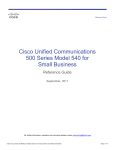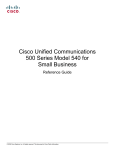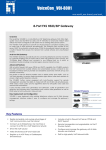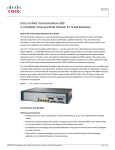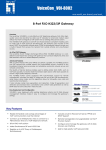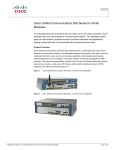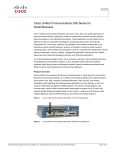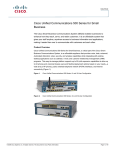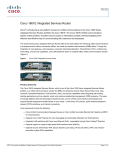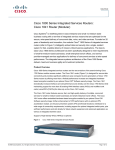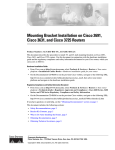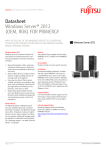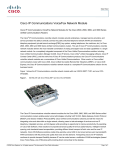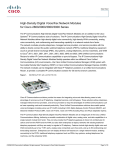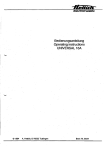Download Cisco Systems UC560T1E1K9 User's Manual
Transcript
Guide Cisco Unified Communications 500 Series Model 560 for Small Business Platform Reference Guide © 2011 Cisco and/or its affiliates. All rights reserved. This document is Cisco Public Information. Page 1 of 12 Product Overview .................................................................................................................................................... 3 Product Part Numbers............................................................................................................................................. 3 Interfaces and Modules........................................................................................................................................... 3 Licensing .................................................................................................................................................................. 4 Basic Call Center Capabilities ................................................................................................................................ 5 Voice Resource Utilization...................................................................................................................................... 6 Localization .............................................................................................................................................................. 8 Hardware Specifications ......................................................................................................................................... 9 © 2011 Cisco and/or its affiliates. All rights reserved. This document is Cisco Public Information. Page 2 of 12 Product Overview ® The Cisco Unified Communications 560 (Figure 1), a central part of the Cisco Smart Business Communications System, is an affordable unified communications appliance that provides voice and data communications, voicemail, automated attendant, video, security, and wireless capabilities while integrating with existing desktop applications such as calendar, email, and customer relationship management (CRM) programs. This easy-tomanage platform supports up to 138 phones and 125 voice mailboxes and provides flexible deployment options based on your needs, including support for a wide array of IP phones, public switched telephone network (PSTN) interfaces, and Internet connectivity. This reference guide describes the specifications and capabilities of the Cisco Unified Communications 560 (UC 560). Figure 1. Cisco UC 560: FXO Model Product Part Numbers The Cisco UC 560 is available in two base versions: an FXO (analog) model and a Basic Rate Interface (BRI) base model. The FXO model is also available with a built-in T1/E1 interface. With ease of ordering as a focus area, each has its own product ID. In addition, there is one software licensing product, multiples of which can be installed to achieve the desired user count. Table 1 lists the part numbers for the Cisco UC 560. Table 1. Product Part Numbers for the Cisco UC 560 Part Number Description UC560-FXO-K9 UC 560 system with 4 FXO, 4 FXS, and 2 voice interface card (VIC) expansion slots UC560-BRI-K9 UC 560 system with 2 BRI, 4 FXS, and 2 VIC expansion slots UC560-T1E1-K9 UC 560 system with 4 FXO, 4 FXS, 1 T1/E1, and 1 VIC expansion slot L-UC-PRO-8U= Software license upgrade, authorizing an additional 8 users (e-delivery) Interfaces and Modules The Cisco UC 560 has built-in interfaces that offer fixed configurations, reducing complexity. In addition, this platform offers voice interface card (VIC) slots to support additional Cisco VIC modules. Table 2 lists the built-in interfaces, and Table 3 lists the modular interfaces supported on the UC 560. Table 2. Built-In Interfaces Supported on the Cisco UC 560 Interface Description Music on hold (MoH) port Single 3.5-mm audio port Onboard Ethernet ports ● Three 10/100/1000 Ethernet expansion ports1 ● One 10/100/1000 WAN uplink 1 One of the three expansion ports defaults to a PC/LAN port to enable configuration of the box and/or to connect to a server. The port can be changed to function as an expansion port. © 2011 Cisco and/or its affiliates. All rights reserved. This document is Cisco Public Information. Page 3 of 12 Interface Description FXS and direct inward dialing (DID) ports 4 built-in FXS ports (DID is available via the additional module listed in Table 3) PSTN interfaces (FXO, BRI, or T1/E1) 4 FXO, 2 BRI, or 4 FXO with built-in T1/E1 Table 3. Modular VIC Cards for the Cisco UC 560 Part Number Description VIC-4FXS/DID, VIC3-4FXS/DID 4-port FXS/DID module VIC2-2FXS 2-port FXS module VIC2-2FXO 2-port FXO module VIC3-2FXS/DID 2-port FXS/DID module VIC2-4FXO 4-port FXO module VIC2-2BRI-NT/TE 2-port BRI NT/TE module VWIC2-1MFT-T1/E1 1-port T1/E1 for voice (ISDN Primary Rate Interface [PRI] and channel associated signaling [CAS]); data is not supported 2 VWIC2-2MFT-T1/E1 2-port T1/E1 for voice (ISDN PRI and CAS); data is not supported Licensing The Cisco UC 560 includes 24 user licenses. These licenses enable the use of Cisco IP phones and allow users to access the IP PBX features, including voicemail. In addition, supplementary user licenses are bundled to help with deployments that need a few extra licenses. For additional licensing needs, the L-UC-PRO-8U= may be ordered. This increases the existing license count by eight. Table 5 lists the number of users supported based on the hardware/license configurations. The UC 560 also has built-in licenses for unified communications features. Table 4 lists the license count bundled with the system for each feature. Guidance for licenses associated with unified messaging on the UC 560 is included in Table 6. Note: Table 4. Out of the 24 base licenses provided with the UC560 8 are supplemental licenses. Licensing and User Capacity for the Cisco UC 560 License Configuration Description UC560 (FXO, BRI, or T1E1 model) 24 user licenses, 6 supplemental user licenses UC560 (FXO, BRI, or T1E1 model) and 1 x L-UC-PRO-8U= 32 user licenses, 8 supplemental user licenses UC560 (FXO, BRI, or T1E1 model) and 2 x L-UC-PRO-8U= 40 user licenses, 8 supplemental user licenses UC560 (FXO, BRI, or T1E1 model) and 3 x L-UC-PRO-8U= 48 user licenses, 8 supplemental user licenses UC560 (FXO, BRI, or T1E1 model) and 4 x L-UC-PRO-8U= 56 user licenses, 8 supplemental user licenses UC560 (FXO, BRI, or T1E1 model) and 5 x L-UC-PRO-8U= 64 user licenses, 8 supplemental user licenses UC560 (FXO, BRI, or T1E1 model) and 6 x L-UC-PRO-8U= 72 user licenses, 8 supplemental user licenses UC560 (FXO, BRI, or T1E1 model) and 7 x L-UC-PRO-8U= 80 user licenses, 10 supplemental user licenses UC560 (FXO, BRI, or T1E1 model) and 8 x L-UC-PRO-8U= 88 user licenses, 10 supplemental user licenses UC560 (FXO, BRI, or T1E1 model) and 9 x L-UC-PRO-8U= 96 user licenses, 10 supplemental user licenses UC560 (FXO, BRI, or T1E1 model) and 10 x L-UC-PRO-8U= 104 user licenses, 10 supplemental user licenses UC560 (FXO, BRI, or T1E1 model) and 11 x L-UC-PRO-8U= 112 user licenses, 10 supplemental user licenses 2 A maximum of two T1/E1 cards are supported on a UC 560. VWIC2-2MFT-T1/E1 will not work on a UC560-T1E1-K9 model. © 2011 Cisco and/or its affiliates. All rights reserved. This document is Cisco Public Information. Page 4 of 12 License Configuration Description UC560 (FXO, BRI, or T1E1 model) and 12 x L-UC-PRO-8U= 120 user licenses, 10 supplemental user licenses UC560 (FXO, BRI, or T1E1 model) and 13 x L-UC-PRO-8U= 128 user licenses, 10 supplemental user licenses Table 5. Feature Licensing for the Cisco UC 560 Feature Number of Licenses Included Virtual LANs (VLANs) 3 15 VPN tunnels 20 Remote teleworker sites 20 Users per teleworker site 5 Multisite deployments 5 Table 6. Unified Messaging Licensing for the Cisco UC 560 Configuration Unified Messaging Licenses Base Voicemail license 125 mailboxes4 Default voicemail storage per mailbox 12 minutes Sessions to voicemail and automated attendant 12 Internet Message Access Protocol (IMAP) sessions 20 Note: 4 In large deployments, It is very typical to have faxes and common area phones which do not require voicemail or voicemail boxes hence the number of voicemail boxes do not match the exact phone count. Basic Call Center Capabilities The Cisco UC 560 supports basic automatic call distribution (B-ACD) that can help answer outside calls with greetings and menus and allow callers to select the appropriate departments. B-ACD also provides managed call queues for calls that are waiting to be answered. Table 7 lists the B-ACD capabilities of the UC 560. Table 7. Cisco UC 560 B-ACD Capabilities Feature Number Hunt groups associated with B-ACD 10 Calls allowed in each call queue 30 Agents (members) for each hunt group 20 Statistics accumulated for all B-ACD groups 168 hours Hunt groups used with automated attendant 3 3 Includes IP Security (IPsec), Secure Sockets Layer (SSL), or generic routing encapsulation (GRE) tunnels. There are 20 simultaneous sessions available between IMAP Client and IMAP server. If all 20 sessions are used up, the remaining session requests will be rejected by the IMAP server. IMAP clients will automatically attempt to establish session with the server once some of the server ports are freed up. This does not limit the number of IMAP clients to 20. 4 © 2011 Cisco and/or its affiliates. All rights reserved. This document is Cisco Public Information. Page 5 of 12 Voice Resource Utilization The Cisco UC 560 includes eight digital signal processors (DSPs) that enable digitized voice processing on the platform. The DSP resources available on the platform are used for various unified communications features, namely support of analog and digital VICs, prescheduled or ad hoc voice conference calls, and translation of digitized voice from a less complex codec (such as g711) to a more complex codec (such as g729) - typically used for deployments that use IP trunking (SIP or H.323) for PSTN access or multisite interconnection. Each DSP can support 16 g711 channels or 8 g729 channels. This enables a total of 128 g711 channels on the Cisco UC 560. Table 8 indicates the DSP resource utilization for each feature. Tables 9 and 10 show a few deployment scenarios based on combinations of these features. Table 8. DSP Resource Utilization on the Cisco UC 560 Feature DSP Resource Utilization Support for built-in FXS ports 4 channels Support for built-in FXO ports 4 channels Support for built-in music on hold (MoH) port 2 channels Support for T1/E1 voice/WAN interface card (VWIC) 24 channels5 Transcoding (g711 to g729) 2 channels 6 Conferencing 16 channels Tables 9 and 10 list the maximum sessions for either ad hoc conferencing or meet-me conferencing. DSP resources allocated for conferencing can be shared by both features, and a mix of these can be configured. Below are a few examples based on Table 9. The concept of sharing conferencing resources applies to Table 10 as well. Ad hoc 56x8 Meet-me 0x0 Ad hoc 28x8 Meet-me 28x8 Ad hoc 56x4 Meet-me 7x32 The above examples indicate Sessions x Participant. The Transcoding column lists the maximum number of transcoding sessions that the system can be configured for, for a given configuration of DSPs. For example, the first row in Table 9 indicates that a maximum of three transcoding sessions are available if seven DSPs are allocated for conferencing. If more transcoding sessions are required, DSP resources will need to be diverted from conferencing to transcoding. For example, in the second row of Table 9, one of the DSPs is dedicated to transcoding, leaving six DSPs for conferencing. Notice the increase in the number of transcoding sessions and the drop in the number of conferencing sessions. 5 Total DSP resources will depend upon the number of channels provisioned in the T1. Conferencing always uses up an entire DSP. The rest of the features can share a DSP. The number of sessions available will vary depending upon the codec used in a conference call. 6 © 2011 Cisco and/or its affiliates. All rights reserved. This document is Cisco Public Information. Page 6 of 12 Table 9. DSP Resources: Scenario 1 UC500 Model Additional Voice Card (VIC) SIP Trunk Preferred Codec Ad-hoc Conference (Sessions x Participants) UC 560 None No SIP Trunk or G.711 Up to a maximum of Up to a maximum of 56x8 or 104x4 48x8 or 24x16 or 12x32 ● 1 DSP for supporting voice ports and transcoding sessions ● Remaining 7 DSPs used for conferencing A maximum of 3 transcoding sessions for this configuration G.729 Up to a maximum of Up to a maximum of 12x8 or 24x4 12x8 or 6x16 or 3x32 ● 1 DSP for supporting voice ports and transcoding sessions ● 1 DSP reserved for transcoding ● Remaining 6 DSPs used for conferencing A maximum of 11 transcoding sessions for this configuration No SIP Trunk or G.711 Up to a maximum of Up to a maximum of 56x8 or 104x4 56x8 or 28x16 or 14x32 ● 1 DSP for supporting voice ports and transcoding sessions ● Remaining 7 DSPs used for conferencing A maximum of 2 transcoding sessions for this configuration G.729 Up to a maximum of Up to a maximum of 12x8 or 24x4 12x8 or 6x16 or 3x32 ● 1 DSP for supporting voice ports and transcoding sessions ● 1 DSP reserved for transcoding ● Remaining 6 DSPs used for conferencing A maximum of 10 transcoding sessions for this configuration No SIP Trunk or G.711 Up to a maximum of Up to a maximum of 56x8 or 104x4 56x8 or 28x16 or 14x32 ● 1 DSP for supporting voice ports and transcoding sessions ● Remaining 7 DSPs used for conferencing A maximum of 1 transcoding sessions for this configuration G.729 Up to a maximum of Up to a maximum of 12x8 or 24x4 12x8 or 6x16 or 3x32 ● 1 DSP for supporting voice ports and transcoding sessions ● 1 DSP reserved for transcoding ● Remaining 6 DSPs used for conferencing A maximum of 9 transcoding sessions for this configuration Transcoding sessions recommended 2FXS 2FXS/DID 2FXO Transcoding sessions recommended 4FXS 4FXS/DID 4FXO Meet-me Conference (Sessions x Participants) 2BRI NT/TE Transcoding sessions recommended © 2011 Cisco and/or its affiliates. All rights reserved. This document is Cisco Public Information. Comments Transcoding Page 7 of 12 Table 10. DSP Resources: Scenario 2 UC500 Model Additional Voice Card (VIC) SIP Trunk Preferred Codec Ad-hoc Conference (Sessions x Participants) UC 560 1MFT T1/E1 No SIP Trunk or G.711 Up to a maximum of Up to a maximum of 56x8 or 104x4 56x8 or 28x16 or 14x32 ● 1 DSP for supporting voice ports, fractional T1/E1 and transcoding sessions ● Remaining 7 DSPs used for conferencing 0 session for 6 ch Up to a maximum of Up to a maximum of 12x8 or 24x4 12x8 or 6x16 or 3x32 ● 1 DSP for supporting voice ports, fractional T1/E1 and transcoding sessions ● 1 DSP reserved for transcoding ● Remaining 6 DSPs used for conferencing 8 sessions for 6 ch Up to a maximum of Up to a maximum of 48x8 or 96x4 48x8 or 24x16 or 12x32 ● 2 DSPs for supporting voice ports, and transcoding sessions ● 1 DSP reserved for transcoding ● Remaining 5 DSPs used for conferencing 0 sessions for 22 ch ● 3 DSPs for supporting voice ports, and transcoding sessions ● 0 DSP reserved for transcoding ● Remaining 5 DSPs used for conferencing 8 sessions for 22 ch No. of Ch ≤ 6 G.729 Transcoding sessions recommended 1MFT T1/E1 6 ≤ No. of Ch ≤ 22 No SIP Trunk or G.711 G.729 Transcoding sessions recommended 1MFT Full T1 Up to a maximum of Up to a maximum of 10x8 or 20x4 10x8 or 5x16 Comments Transcoding 1 session for 4 ch 2 sessions for 2 ch 9 sessions for 4 ch 10 sessions for 2 ch 1 session for 20 ch 2 sessions for 18 ch And so on… 9 sessions for 20 ch 10 sessions for 18 ch And so on… No SIP Trunk or G.711 Up to a maximum of Up to a maximum of 40x8 or 80x4 40x8 or 20x16 or 10x32 ● 3 DSPs for supporting voice ports, and transcoding sessions ● Remaining 5 DSPs used for conferencing A maximum of 7 transcoding sessions, disable conferencing for more transcoding G.729 Up to a maximum of Up to a maximum of 10x8 or 20x4 10x8 or 5x16 ● 3 DSP for supporting voice ports, and transcoding sessions ● 0 DSP reserved for transcoding ● Remaining 5 DSPs used for conferencing A maximum of 7 transcoding sessions, disable conferencing for more transcoding No SIP Trunk or G.711 Up to a maximum of Up to a maximum of 40x8 or 80x4 40x8 or 20x16 or 10x32 ● 3 DSPs for supporting voice ports, and transcoding sessions ● Remaining 5 DSPs used for conferencing A maximum of 4 transcoding sessions, disable conferencing for more transcoding G.729 Up to a maximum of Up to a maximum of 10x8 or 20x4 10x8 or 5x16 ● 3 DSP for supporting voice ports, and transcoding sessions ● 0 DSP reserved for transcoding ● Remaining 5 DSPs used for conferencing A maximum of 4 transcoding sessions, disable conferencing for more transcoding Transcoding sessions recommended 1MFT Full T1 Meet-me Conference (Sessions x Participants) Transcoding sessions recommended Localization Cisco UC 500 series is enabled with localization for IP Phones, Voicemail and Dial Plan. Table 11 summarizes the localization support on the platform. © 2011 Cisco and/or its affiliates. All rights reserved. This document is Cisco Public Information. Page 8 of 12 Table 11. Localization support on UC 500 Series Hardware Specifications The hardware specifications for the Cisco UC 560 include physical specifications, environmental specifications, power specifications, and regulatory compliance. Table 12 lists the physical specifications. Table 13 lists the power requirements for the platform. Table 14 provides the environmental specifications, and Table 15 shows the compliance information. Table 12. Physical Specifications for the Cisco UC 560 Feature Description Packaging type Rack Mount form factor (2 rack units high) Console port (up to 115.2 kbps) 1 7 Auxiliary port 1 7 The auxiliary port on the Cisco UC 560 is the same as the console port. The port has the ability to auto-detect modem tones and switch over to the auxiliary port capability. © 2011 Cisco and/or its affiliates. All rights reserved. This document is Cisco Public Information. Page 9 of 12 Table 13. Power Specifications for the Cisco UC 560 Feature Description AC input voltage 100 to 240V AC AC input frequency 50 to 60 Hz AC input current 3 to 1.5A (100 to 240V) AC input surge current 30 to 60A (100 to 240V) Power dissipation (AC) 67W Table 14. Environmental Specifications for the Cisco UC 560 Feature Description Operating temperature 32° to 104°F Operating humidity Nonoperating temperature Operation altitude ● 10% to 85% noncondensing, operating ● 5% to 95% noncondensing, nonoperating 4° to 149°F (-20° to 65°C) ● 104°F (40°C) at sea level ● 87.8°F (31°C) at 6000 ft (1800 m) ● 77°F (25°C) at 10,000 ft (3000 m) ● 34.7°F (1.5°C) per 1000 ft Dimension (H x W x D) 3.5 x 17.25 x 13.78 in. (8.89 x 43.82 x 35.00 cm) Power supply dimensions (H x W x D) Internal power supply Rack height 2 rack units (RU) Weight (fully configured) 14.5 lb (6.58 kg) Noise level (minimum and maximum) Normal operating temperature: ● < 81°F (27°C): 37 dBA ● < 93°F (34°C): 44 dBA ● 54 dBA (at maximum fan speed) Table 15. Category Safety Regulatory Compliance for the Cisco UC 560 Compliance ● IEC 60950-1 ● AS/NZS 60950.1 ● CAN/CSA-C22.2 No. 60950-1 ● EN 60950-1 ● UL 60950-1 Immunity ● EN 55024 ● EN 300-386 ● EN 61000-6-2 ● EN 50082-1 ● EN 55024 (CISPR 24) © 2011 Cisco and/or its affiliates. All rights reserved. This document is Cisco Public Information. Page 10 of 12 Category Electromagnetic compatibility (EMC) Compliance ● FCC Part 15, ICES-003 ● EN55022, CISPR 22 ● AS/NZS ● CNS13438 ● VCCI V-3 ● EN 55024 ● EN 300-386 ● EN 61000-3-2 ● EN 61000-3-3 ● EN 50082-1 ● EN 55024 (CISPR 24) ● EN 61000-4-2 ● EN 61000-4-3 ● EN 61000-4-4 ● EN 61000-4-5 ● EN 61000-4-6 ● EN 61000-4-8 ● EN 61000-4-11 ● EN 61000-6-2 Telecommunications ● FXS/DID ● TIA-968-A3 ● CS-03 Part I ● ACIF S002 ● ACIF S003 ● ANZ PTC200 ● ISDN BRI S/T (voice and data BC) ● TIA-968-A3 ● CS-03 Part VI ● TBR3 ● ACIF S031 ● ANZ PTC200 ● MPMHAPT Japan Digital ● FXO ● TIA-968-A3 ● CS-03 Part I ● TBR21 ● MPMHAPT Japan Analog ● ACIF S002 ● ACIF S003 ● ACIF S004 ● ANZ PTC200 ● MOH interface ● ACIF S038 ● ACIF S004 ● TIA-464C © 2011 Cisco and/or its affiliates. All rights reserved. This document is Cisco Public Information. Page 11 of 12 Printed in USA © 2011 Cisco and/or its affiliates. All rights reserved. This document is Cisco Public Information. C07-566560-02 09/11 Page 12 of 12












